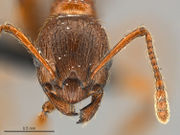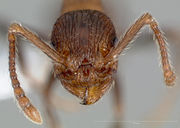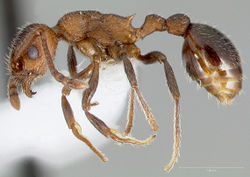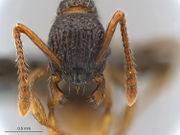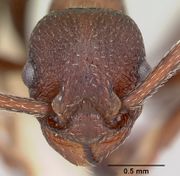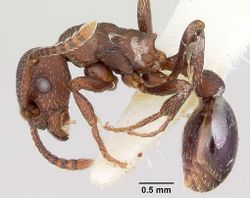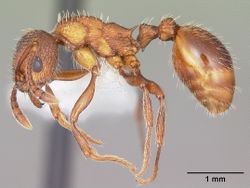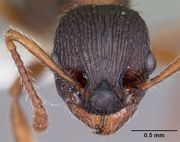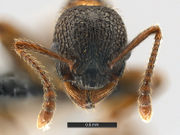Key to Myrmica of North America
This key to North American species of Myrmica is a work-in-progress and should be used as a guide only. This group is in serious need of taxonomic work and this key is a small contrubution to this effort.
1
- Petiolar node high, distinctly set off from anterior and posterior peduncles and angular at crest; ventral surface of petiole with distinct, obtusely angular impression formed by the junction of the anterior and posterior peduncles; Arizona => Myrmica wheeleri
- Petiolar node not distinctly set off from anterior and posterior peduncles or, if so, it is low and much rounded above; ventral surface of petiole straight or very feebly convex => 2
2
- Outer edge of frontal lobe feebly convex throughout most of its length and fusing with head without marked posterior incision; frontal area distinct, not crossed by rugae, usually smooth and strongly shining; Quebec, Maine, Massachusetts, Rhode Island => Myrmica rubra, Myrmica rubra neolaevinodis
- Outer edge of frontal lobe strongly convex or angular in front, or deeply incised behind, or both; frontal area obscured by rugae, never completely smooth and shining (except in M. punctiventris) => 3
3
- Frontal lobes narrow, scarcely or not at all projecting above antennal fossae; insertions of antennae exposed when head is viewed from above; Tennessee, Mississippi, Illinois => Myrmica spatulata
- Frontal lobes strongly projecting out over antennal fossae; insertions of antennae hidden when head is viewed from above => 4
4
- Antennal scape evenly curved at base, upper surface never forming right angle at bend (sometimes about 80°), flange at bend, if present, low and inconspicuous => 5
- Antennal scape sharply bent at base, upper surface forming right angle or nearly so, flange at bend always present and obvious, of varying shapes => 15
5
- Lateral portion of clypeus raised into carina which forms abrupt, semi-circular boundary at front of antennal fossa (as in Tetramorium) => Myrmica rugiventris
- Clypeus not as above => 6A
6A
- Frontal area mostly smooth and glossy and with at most 1 or 2 short posterior rugae which are less than half the length of the frontal area => 6B
- Frontal area roughly sculptured, with several rugae which extend at least 1/2 its length => 6
6B
- First gastric segment without coarse, large punctures; propodeal spines elongated with a narrow, thin base; California => Myrmica punctinops
- First gastric segment with coarse, large piliferous punctures; propodeal spines short and dentiform with a large, thick base; eastern North America => Myrmica semiparasitica
6
- Mesonotum raised above the dorsal surface of propodeum so that they fall on separate lines and the metanotal groove forms a step between them; gaster with numerous coarse punctures with diameters at least 5X diameter of hairs arising from them => 7
- Mesonotum and dorsal surface of propodeum forming a continuous surface (which is interrupted by the metanotal groove); gaster with fine punctures, whose diameter is less than 3X diameters of hairs => 8
7
- Antennal scapes surpassing occipital margin by an amount equal to their greatest thickness; propodeal spines distinctly longer than the distance separating their tips and slightly deflected downward; dorsal surface of head coarsely striated, rugae high and thick with flattened top in cross section; frontal lobes smaller, difference between maximum and minimum width usually < 0.12 mm; color piceous brown; length 4.0-4.7 mm; Massachusetts to Georgia to Iowa, Nebraska, Arkansas, Texas => Myrmica punctiventris
- Antennal scapes barely surpassing occipital margin; propodeal spines shorter, about equal to the distance separating their tips, not deflected downward; dorsal surface of head delicately striated, rugulae low and rounded in cross section; frontal lobes larger, difference between maximum and minimum width usually > 0.12 mm; color brownish yellow; length 3.5-4.0 mm; Massachusetts to South Carolina, west to Ohio, Oklahoma, Mississippi => Myrmica pinetorum
8
- Gaster with longitudinal striae extending about 2/3 length of first gastral tergum, sparsely, but distinctly; punctate; inquiline in nest of Myrmica striolagaster; Texas (Davis Mts.) => Myrmica colax
- Gaster without longitudinal striae => 9
9
- Frontal lobes angular, strongly expanded laterally and slightly deflected downwards towards the scape, their widest point at or posterior of antennal insertions => 11
- Frontal lobes rounded and relatively narrow, moderately to strongly elevated away from scape, their widest point anterior of antennal insertions => 13
11
- Postpetiole with shining dorsal area that is largely free from rugae; average size of workers 3.5 mm; Alaska, Quebec => Myrmica alaskensis
- Postpetiole ordinarily covered with rugae, rarely with dorsal area free from rugae, but in such cases this area is not shining; average size of workers at least 4.5 mm; Labrador south to New Jersey, west to Rocky Mountains, Wyoming, New Mexico => Myrmica incompleta
13
- Propodeal spines slightly less than one-half as long as distance which separates tips; color variable, but often orange-yellow; North Dakota, Nebraska to New Mexico, west to Alberta, Idaho => Myrmica brevispinosa
- Propodeal spines more than ½ as long as distance which separates tips; color dark brown => 14
14
- Area between lateral ocellus and eye of male mostly punctate; Newfoundland to mountains of Colorado, Wyoming, New Mexico => Myrmica discontinua
- Area between lateral ocellus and eye mostly with reticulate rugae; eastern Mexico (Nuevo Leon, Coahuila south to Veracruz) => Myrmica mexicana
15
- Flange at bend of antennal scape continuing a short distance along scape towards tip => Myrmica nearctica
- Flange at bend of antennal scape transverse and sometimes collar-like, never elongate and rarely extending along scape towards tip (when present the extension is low and short compared to remaining flange) => 17
17
- Scape covered with longitudinal rugae; gaster with longitudinal striae on first tergum, obvious at least near point of attachment of post petiole (gradient exists with less developed striae in western populations); gaster with coarse punctures with diameters about 5X diameter of hairs; Arizona (Chiricahua Mountains), New Mexico (entire state), West Texas, Chihuahua (entire state), Colorado => Myrmica striolagaster
- Scape usually with fine sculpture, mostly punctate; gaster without striae and with punctures whose diameter is less than 3X diameter of hairs => 18
18
- Ventral surface of postpetiole seen in profile flat or nearly so and not forming anterior projection; antennal scapes of male as long or longer than following 4 segments together and straight at base; Quebec, Maine to North Carolina, Tennessee to Manitoba, Colorado, Utah, Arizona => Myrmica americana
- Ventral surface of postpetiole seen in profile convex or forming prominent anterior projection that thrusts forward under anterior peduncle; antennal scapes of male bent at base, or if straight they are distinctly shorter than above => 19
19
- Flange at bend of antennal scape large (much broader than scape itself) and semicircular, surrounding scape at bend => 20
- Flange at bend of antennal scape small, sometimes cup-like, at most only slightly wider than scape and never surrounding it => 22
20
- Flange at bend of antennal scape under-cut on inner face, forming a distinct hook; Colorado, New Mexico, Arizona, Utah => Myrmica hamulata
- Flange at bend of antennal scape with inner face rounding uniformly into scape => 21A
21A
- Petiolar node with distinct dorsal and posterior faces which are separated by a rounded angle => Myrmica trullicornis
- Petiolar node with a relatively long dorsal face with rounds gradually into a short, often indistinct, posterior face, the separation of these faces minimal or absent => 21B
21B
- Flange at bend of antennal scape with a ridge towards antennal insertion and a "U"-shaped, cup-like structure above bend => Myrmica crassirugis
- Flange at bend of antennal scape a single ridge that begins near antennal insertion and ends immediately above bend => 21C
21C
- Utah, Colorado, Arizona, New Mexico => Myrmica monticola
- North Dakota, Iowa east to Nova Scotia, Virginia => 21D
21D
- Body smaller; promesonotum uniformly convex; dorsal surface of propodeum uniformly convex; interrugal sculpturing on head weakly developed and more shiny, especially posterior of antennal insertion; North Carolina, Massachusetts, Illinois, Maine, Michigan, D.C., New Jersey, New York, Missouri, Indiana, Georgia, Iowa, Connecticut => Myrmica species "smitha"
- Body larger; promesonotum strongly convex anteriroly (immediately posterior of collar) and weakly convex posteriorly (along the dorsal surface); dorsal surface of propodeum more strongly arched anteriorly, weakly convex to nearly flat posteriorly; interrugal sculpturing on head well developed and less shiny, especially posterior of antennal insertion; Massachusetts, Maine, New York => Myrmica species "sculp"
22
- Flange at bend of antennal scape a single ridge that begins near antennal insertion and ends immediately above bend => 22A
- Flange at bend of antennal scape with a ridge towards antennal insertion and a "U"-shaped, cup-like structure above bend => 23
22A
- Flange at bend of antennal scape less extensive, ending at or just before bend; Newfoundland to Georgia west to Manitoba, Idaho, Colorado, Arizona => Myrmica latifrons
- Flange at bend of antennal scape more extensive, extending slightly distally of and beyond bend => Myrmica detritinodis
23
- Flange at bend of antennal scape less extensive, reduced to a narrow (less than scape width), thin band across the outer surface of scape => Myrmica fracticornis
- Flange at bend of antennal scape larger, cup-shaped and slightly wider than scape width => 24
24
- Body smaller, head width < 0.95mm => Myrmica tahoensis
- Body larger, head width > 1.0mm => 25
25
- Posterior region of mesonotum elevated above metanotal groove; rugae on promesonotum irregular; petiolar node higher, dorsal surface shorter and set off from posterior face by a slight angle; hairs on first gastral segment arising from small pits => Myrmica species "magn"
- Posterior region of mesonotum merging gently into metanotal groove; rugae on promesonotum largely parallel; petiolar node lower, dorsal surface longer and merging into posterior face; hairs on first gastral segment arising directly from the integment, lacking pits => Myrmica wheelerorum


